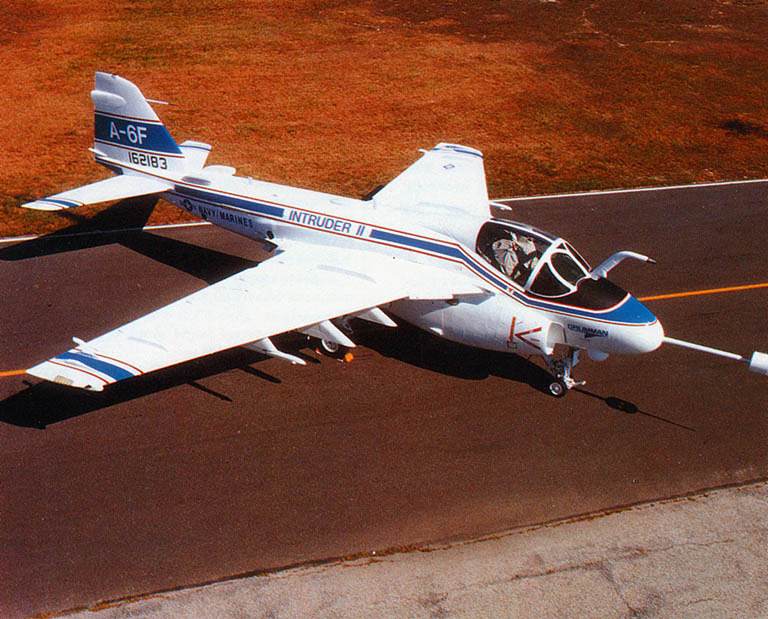Description & History
In 1983, Grumman developed a proposal for an A-6E Upgrade Program that aimed to significantly enhance the combat effectiveness and extend the service life of the Intruder. This coincided with the US Navy’s Advanced Tactical Aircraft (ATA) program, also launched in 1983, which sought a long-term replacement for the A-6 Intruder, eventually resulting in the planned A-12 Avenger II, produced by McDonnell Douglas. Nevertheless, in July 1984, the Navy approved a development contract for a new and advanced version of the A-6E, anticipating that the Intruder would remain the Fleet’s principal medium attack aircraft into the late 1990s.
This upgrade would become known as the A-6F Intruder II. The design included the new AN/APQ-173 synthetic aperture radar, a Collins GPS, ALR-67 radar warning system, integrated AN/ALQ-165 jamming gear, a digital avionics suite with a glass cockpit, and a redesigned epoxy/composite wing built by Boeing. Power would come from smokeless, non-afterburning F404-GE-400D turbofans, producing 10,800 lbf of thrust each and sharing 99% commonality with the afterburning engines used on the F/A-18 Hornet. Two additional wing pylons were added, enabling the A-6F to carry AIM-120A AMRAAMs or AIM-9 Sidewinders without sacrificing some payload of air-to-ground munitions, a capability made possible by the new air-to-air radar. Importantly, the TRAM targeting system from the A-6E was retained without change.
Externally, the A-6F differed from the A-6E TRAM by featuring deeper engine nacelles, smaller radar antennae, additional vents and scoops, and two large ram-air ducts forward of the vertical stabilizer for cooling avionics. ECM receivers were also mounted above the wing fuel tank vents, as seen later on the A-6E SWIP.
The A-6F program promised major improvements in survivability, mission readiness, and maintenance efficiency, with estimates projecting a 20–30% reduction in maintenance requirements and a 70% mission-capable rate. Impressively, the airframe remained essentially unchanged, allowing for low-cost upgrades of existing A-6Es to A-6F standard. The Navy ordered five full-scale development aircraft, with plans for 150 new-build A-6Fs to begin production in FY1988 and first deliveries scheduled for 1989.
The first A-6F (BuNo 162183), converted from an A-6E, made its maiden flight on August 26, 1987, focused on testing aerodynamic and propulsion characteristics. It was followed by BuNo 162184 on November 23, 1987, and BuNo 162185 on August 22, 1988, which served as a testbed for the AN/APQ-173 and other avionics. Development progressed rapidly, with the Navy establishing a joint F-14D and A-6F program at NAS Patuxent River, aiming for fleet introduction in the early 1990s. Initial evaluations of the A-6F exceeded expectations.
However, by 1988, the Navy had fully committed to the A-12 program, and despite internal opposition, it decided to terminate the A-6F, halting development and canceling production. The final two A-6Fs were never flown and remained mothballed. Plans to build the production aircraft were also cancelled. In total, only five A-6Fs were built, accumulating just 2.5 hours of flight time before the program was shut down.
Ironically, the A-12 Avenger II, which emerged from the same 1983 ATA initiative, was itself cancelled by Secretary of Defense Dick Cheney on January 7, 1991. This decision left the Pentagon with possibly no choice but to rely more heavily on the F/A-18 Hornet to fill multiple attack roles across the fleet. In the aftermath, Grumman proposed a cost-saving alternative: the A-6G, which retained all the upgrades of the A-6F but used the existing A-6E engines. This, too, was rejected, and the proposal was abandoned, ultimately ending the ongoing development of the Intruder series, with the A-6E SWIP being the final modification before the Intruder’s retirement in February 1997.







